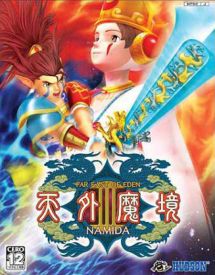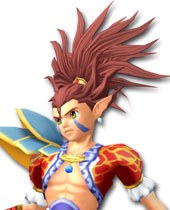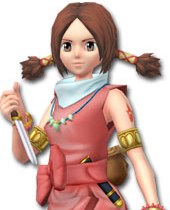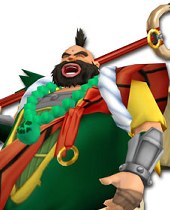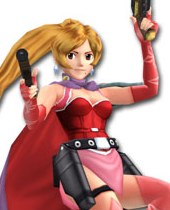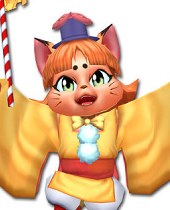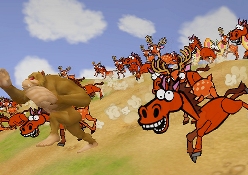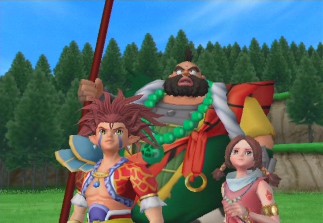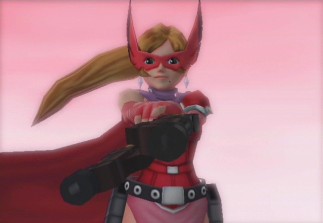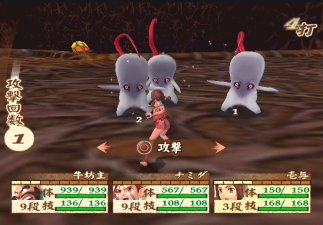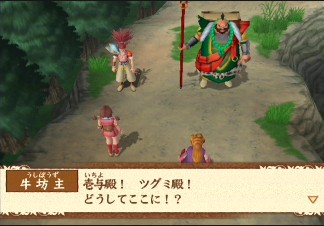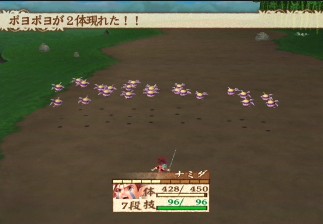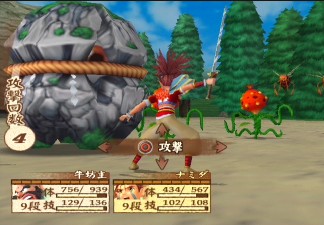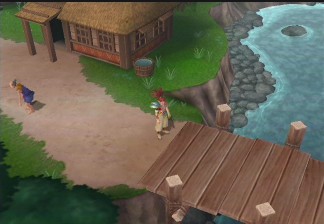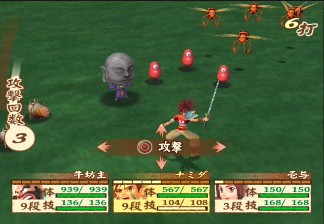
Tengai Makyō - Far East of Eden
|
Next Page >>> |
|
Page 1: |
Page 2: |
Page 3: |
Page 4: |
|
Tengai Makyō III has been a long time in the making. Initially conceived for NEC's PC-FX (the successor to the PC Engine), it was canned around 1995 due to the amazing failure of the console. Ten years later (and after a complete makeover), Hudson revived the series for the PlayStation 2. After a huge bunch of detours into fighters, FMV games and parodies of American culture, Tengai Makyō is back with the true sequel to Manjimaru. And other than the 3D graphics, not a whole lot has changed.
There's nothing particular new about the plot - Namida is a young man with amnesia, having washed ashore onto a small village when he was a little boy. When evil demons - known as Ami - kidnap his friend Ichiyo and destroy their town, it's up to him to save her. Naturally, Namida has "great power", and after rescuing his friend, sets off on a journey to free Jipang from the evil demon leader and his crew of villains. There are many more playable characters here than most of the other games in the series, although you can only have three in battle at a time. Here's a few of them:
Characters
Namida
The hero of the game. You can bet tragedy is about, considering his name means "tears". The not-so-subtle tattoos also drive the point home.
Ichiyo
Ichiyo is the cliched childhood friend, but while she starts off as a damsel-in-distress, she quickly becomes a member of your party. She also wields of the power of fire in this one.
Ushibouzu
A gigantic fellow who runs an orphanage. His name literally means "cow priest", which explains the nose ring and horns on the end of his staff.
Tsugumi
This dual-pistol wielding lady dresses in an absurd outfit and occasionally wears an equally ridiculous mask.
The structure is much like Manjimaru - there are huge overworld maps to explore at your leisure, and once again, you obtain magic spells by visiting Tengu hideaways. Some of it does come across as a bit dated, especially given the extreme amount of backtracking you'll need to do, but people bemoaning the linear, cinematic nature of modern RPGs will be pleased. Thankfully, the battle system has been given a huge overhaul, ditching the old-fashioned first-person combat. While most RPGs have you fighting three, maybe four bad guys at a time, Namida routinely tosses between ten and thirty foes to battle against. Each attack by your character can knock out as many as a dozen enemies at once, so combat moves quickly, and it's pretty cool to see your characters plow through rows of enemies like a bowling ball, sending your worthless enemies flying aside. Each character has a certain number of attacks per round, and can vary between regular attacks or special abilities. There's also a power meter that builds up as you inflict or take damage, allowing you to do an special attack that can be turned into combos with your fellow party members. Your abilities gain experience the more you use them, giving incentive to make great use of the various abilities.
The biggest problem, unfortunately, are the load times, which was also a problem with the PlayStation 2 version of Tengai Makyō II. Every time you change a screen (including entering and exiting houses in towns), you're greeted by a load time of between three and seven seconds. Battles load quickly, but you still need to wait once you exit them. A version of Namida was initially planned for the GameCube but later scrapped - it's too bad, as the system is known for quick load times and could have potentially fixed this issue. The graphics are pretty average for the most part, which is also something of a shame. Early trailers had anime-style graphics, but all of the cutscenes are done in CG barely better than the ingame engine. Also, early artwork seemed to showcase a cel-shaded style, although apparently this idea was dropped for the final version. On the other hand, the fully orchestrated musical score is superb. The vocal theme sung by Sarah Brightman isn't that great though, and it's odd to have an English song for such a distinctly Japanese game.
While it is a little disappointing that Tengai Makyō returned to its PC Engine roots as opposed to continuing the madcap antics introduced in The Apocalypse IV - it really does feel a bit conservative, both in its sense of humor and mechanics - but Tengai Makyō III is otherwise an enjoyable return to old-school RPG gaming. It was rumored at one point that Konami would bring this out in America, although that idea seems to have been scrapped.
Quick Info:
|
Developer: |
|
|
Publisher: |
|
|
Designer: |
|
|
Genre: |
|
|
Themes: |
Tengai Makyō III: Namida (PlayStation 2)
Tengai Makyō III: Namida (PlayStation 2)
Tengai Makyō III: Namida (PlayStation 2)
Tengai Makyō III: Namida (PlayStation 2)
Tengai Makyō III: Namida (PlayStation 2)
Tengai Makyō III: Namida (PlayStation 2)
Tengai Makyō III: Namida (PlayStation 2)
Tengai Makyō III: Namida (PlayStation 2)
Tengai Makyō III: Namida (PlayStation 2)
Denden no Den wasn't anything entirely too special. It's simply Bomberman but entirely overrun by minature Kabukis. Apparently it was a limited (promotional?) release, so it's not too easy to come across.
Quick Info:
|
Developer: |
|
|
Publisher: |
|
|
Genre: |
|
|
Themes: |
Deden no Den (PC Engine CD)
It would be easy to describe Kabuki Klash as "Samurai Shodown with Tengai Makyō characters" and just be done with it, but that would be lazy. But the comparisons are obvious, right down to the same awkward control scheme (pressing two buttons at the same time to execute a strong attack) and items being tossed into the foreground that restore health, boost power and whatnot. The characters are all grabbed from Ziria and Manjimaru, so if you ever wanted to pit Kabuki against Tsunade to see who is more obnoxious, now is your chance. The roster is a little weak with only eight playable characters, alas. Overall, the game is a little simpler than Samurai Shodown, but it's fairly well executed and kind of fun. Notable for being the first (and only) appearance of Tengai Makyō outside of Japan.
Quick Info:
|
Developer: |
|
|
Publisher: |
|
|
Director: |
|
|
Genre: |
|
|
Themes: |
Kabuki Klash (Neo Geo)
Kabuki Klash (Neo Geo)
Featuring characters from Fūun Kabuki-den, Ittōryōdan isn't quite a sequel to Kabuki Klash - rather than aping Samurai Shodown, it more closely mimics Street Fighter II, right up necessitating the six button pad. (Well, not absolutely, but you don't want to play this with a standard two-button controller.) In addition to Kabuki, Okuni, Zeami and Push Fujiyama, other characters include Kikugorou (Kabuki's masked nemesis from Manjimaru), Mikoshi (one of the ninja sisters from that same game), lovable ape Manto X, clay robot Jingorō, and foul nemesis Gulp. The graphics have taken a substantial hit compared to Kabuki Klash, with less stylized character sprites and mostly static backgrounds. In 1995 though, they were pretty impressive for the aging PC Engine. And considering that most 16-bit home fighting games were either subpar Neo Geo ports or outright terrible trash (Tuff E Nuff? Power Instinct? Strip Fighter?), Ittōryōdan actually holds up almost as well as Capcom's seminal fighter. So while it lacks the frills that we've come to expect nowadays, and even back then, was pretty much just a well-done clone, Kabuki Ittōryōdan is one of the better fighters of the era and certainly the best one the PC Engine.
Quick Info:
|
Developer: |
|
|
Publisher: |
|
|
Director: |
|
|
Genre: |
|
|
Themes: |
Kabuki Ittōryōdan (PC Engine CD)
Kabuki Ittōryōdan (PC Engine CD)
Made for NEC's ill fated PC-FX, Tengai Makyō: Karakuri Kakutoden is a "full motion video fighting game" - which essentially means you occasionally push buttons and watch footage of your character doing some special move. The characters of the first two games make up the good guy side, with the lineup of bad guys including Manto the monkey, Kabuki's rival Red Squirrel, and a S&M catwoman with tiny little kitten helpers. One would have to wonder why they didn't spend the budget for this game making an anime OVA. Screenshots are taken from Mobygames.
Quick Info:
|
Developer: |
|
|
Publisher: |
|
|
Director: |
|
|
Genre: |
|
|
Themes: |
Tengai Makyō: Dennō Karakuri Kakutōden (PC-FX)
Tengai Makyō: Dennō Karakuri Kakutōden (PC-FX)
Related Articles
|
Next Page >>> |
|
Page 1: |
Page 2: |
Page 3: |
Page 4: |
|
